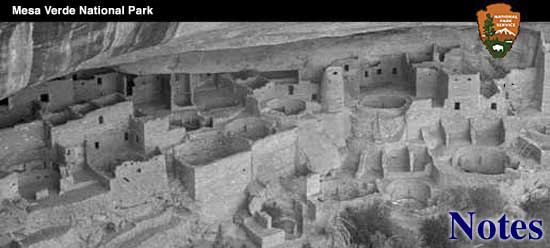

|
A thousand years or so ago a young woman of about twenty, who lived in a small Pueblo village just west of the Mesa Verde, was brutally murdered. With the usual ceremonies she was buried by her sorrowing relatives and during the succeeding centuries the evidence of this ancient tragedy was hidden by the grave. A few years ago Mr. J. Rentz Morrison, of Durango, Colorado, was walking along an old cattle trail near the ruins of a small pueblo when he noticed some partially exposed bones in the ground. With a bit of scratching he exposed a skull. As he picked it up and brushed off the moist earth he found himself face to face with this thousand year old tragedy. 
Protruding from the forehead, an inch above the left eye, was a large, flint blade, either a spear point or a stone knife. Recovering from his first surprise Mr. Morrison extracted the piece of flint from the skull and found that it was three inches long. It had penetrated the brain an inch and a half. For a number of years Mr. Morrison kept the skull in his home where it excited much interest among his friends. In some way the skull became known as "Freda" and the story of the unfortunate young Pueblo woman began to spread. People seemed so interested in the unusual find that Mr. Morrison finally decided that it belonged in a museum where it could be enjoyed by thousands of people instead of only a few. Last Spring "Freda" was brought to the Mesa Verde museum and she is now seen and enjoyed by all of the park visitors. Finds of this kind are very rare. Diseased bones are common and fractured bones are often found but these evidences, in situ, of intentional, external violence are very, very seldom encountered. The evidence in this case is unmistakable. Someone did not like "Freda" and the tragic result is obvious. Even though the case is a thousand years old people seem to enjoy speculating about the cause of "Freda's" sudden demise. Many and varied are the ideas, so to bring some order into the case we might put a modern detective on the trail. Here we have the "corpus delicti"' and the lethal weapon; just how far could a detective go toward solving this ancient mystery? First of all he would consider the sex and age of the victim. By enlisting the aid of any good physical anthropologist he would soon have the answer. The complete lack of eyebrow ridges, the small size of the mastoid bones, the lack of development of the inion, and the lightweight of the bones indicate that the victim was a woman. The age is indicated by the presence of the wisdom teeth and the absence of any suture closure. The wisdom teeth usually appear by the eighteenth or twentieth year; the sutures, or cracks in the skull, begin to close at about twenty-two. Therefore it is safe to say that the woman was twenty or twenty-one years old. To make our mystery more interesting we will assume that she was attractive. Death was caused by a sharp instrument that penetrated the brain. An injury of this kind does not always bring instant death, but since she was buried with the blade still in place it is probably safe to assume that she died within a short time. The instrument was a chipped flint blade, of the shape that is usually called a spear point. These large blades, however, were often knives instead of spear points, having been equipped with short, wooden handles. No actual spears have been found in the ruins in this region so this should probably be called a stone knife. In this case the individual who wielded the knife must have been very strong for it took considerable force to sink the flint blade so deeply into the skull. Now the plot begins to thicken; we are probably safe in saying that the slayer was a man. The position of the knife in the skull indicates that the attacker was directly in front of the victim and was within an arm's length of her. If she was awake she saw the blow coming. At this point our investigator begins to slow up; no further clues are to be found; everything seems blank. The principal trouble, of course, is that there are no witnesses to be interviewed; if there were witnesses to the crime they have been dead these many centuries. Every line of investigation leads to a dead end. We can be fairly sure of certain things: the victim was a woman of about twenty; she was killed by a strong man who wielded a stone knife at close range. Further than this we cannot go; all else is a matter of conjecture. Was it an enemy raid that caused this young woman's death? Did a group of men from an enemy tribe creep up on the small village, strike and slip away before the startled inhabitants could rise in defense of their homes? Or was it a neighborhood quarrel within the village; a struggle between factions or clans, that led to violence? Or was it a family quarrel in which a sudden flare of temper caused this tragedy? What is the answer? Our investigation has proved fruitless. All we can conclude is that even among these early people, whom we consider to have been a peaceful, easy-going group, there were flashes of violence that ended in tragedy. We can only wonder whether the Sherlocks of "Freda's" time were better able to solve the mystery. | ||||||
| <<< Previous | > Cover < | Next >>> |
vol7-2e.htm
14-Oct-2011